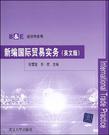新编国际贸易实务
出版时间:2009-8 出版社:清华大学出版社 作者:张雪莹,华欣 主编 页数:276
前言
中国加入WTO,与世界的经济贸易联系更加密切,使得中国与世界其他国家的合作具有了更加广阔的前景。因此,培养既具有国际贸易专业知识又精通外语的复合型人才是目前高等教育的首要任务。正是在这样的时代大背景下,我们于2005年着手编写了《新编国际贸易实务》一书(中文版,清华大学出版社2006年8月第1版,2009年5月第2版),其目的就是帮助广大经贸类专业的学生掌握专业知识和具体的商务贸易规程。随着全球经济一体化程度的加深,一方面我国将需要更多的外贸人才,另一方面对国际贸易专业的学生将提出更高标准,要求其在熟悉掌握专业知识的基础上,能够使用英语进行业务磋商,利用网络营销开展全球贸易并且熟知国际贸易相关条款和惯例。可见,对于国际贸易专业的学生来说,提高自身的综合业务素质是目前最为迫切的任务。正是基于此目的,我们在对《新编国际贸易实务》中文版进行修订的同时,编写了这本与中文版《新编国际贸易实务》相对应的英文版教材,旨在从根本上提高国际贸易实务的双语教学水平。本书以进出口贸易的主要业务环节为主线,系统地介绍了各个环节的操作规程和国际惯例,书中的英文材料大多选自国外原汁原味的英语专业资料,不仅句式地道,而且力求做到英语知识与专业知识相结合,克服了国内教材重语言形式轻语言运用能力的弊端。本书每一章节的编写都注重材料翔实全面,语言难易适中,专业性强的特点,同时结合国际贸易的变化和发展趋势,根据一些贸易规则的修订作了适当的调整。本书的读者对象主要为具有较好英语基础的经贸类专业和英语专业二、三年级的学生,以及有志从事国际贸易工作的其他人士。另外,为了方便广大读者的使用以及与中文版《新编国际贸易实务》相对应,我们将每章课后练习单独成册,并随本教材一起赠送给读者,可作为课外作业本使用。读者可以在清华大学出版社网站(http://www.tup.com.cn)下载练习的答案。本书由张雪莹、华欣担任主编,具体分工为:张雪莹负责全文的校对和课后练习,并编写绪论及第二、三、四章;华欣负责总体框架设计并编写第一、六章;朱蕾编写第五、七、九章;于丽艳编写第十、十二、十三章;王胤编写第十一章;孙虹编写第八章。在编写过程中,我们得到了天津科技大学经济管理学院领导和老师们的大力支持与热心帮助,在此一并表示感谢。
内容概要
本书是与中文版《新编国际贸易实务》相对应的英文版教材,以进出口贸易的主要业务环节为主线,系统地介绍了进出口贸易各个环节的操作规程和国际惯例。内容翔实全面,语言难易适中,专业性强,反映了国际贸易的最新变化和发展趋势。全书共分13章,论述国际货物贸易的特点,商品的品名、品质、数量和包装,国际贸易术语,国际贸易货物运输,国际货物运输保险,国际贸易支付工具,商业信用证,其他支付方式,进出口商品和价格与核算,报关实务与商品检验,进出口交易过程,商业信用证及其中据审核,国际贸易方式,索赔、不可抗力和仲裁等内容。本书配套提供练习册,并为教师提供教学课件和练习答案。 本书的读者对象主要为高等院校具有较好英语基础的经贸类专业和英语专业二、三年级的学生,以及有志从事国际贸易工作的其他人士。
作者简介
张雪莹,经济学硕士,天津科技大学经济与管理学院教师,研究方向为国际贸易理论与实务,曾从事外贸进出口业务数年。主编《世界十大投资经典败局》、《启蒙中国》,参编《商务英语写作》,在核心刊物上发表论文数篇。
书籍目录
Introduction Section 1 Introduction to International Trade Section 2 Reasons for International Trade Section 3 International Trade Restrictions Section 4 Forms of International Trade Chapter One Name, Quality, Quantity and Package of Commodity Section 1 Name of Commodity Section 2 Quality of Commodity Section 3 Quantity of Commodity Section 4 Packaging of Commodity Chapter Two Trade Terms Section 1 Trade Terms and Incoterms 2000 Section 2 Main Trade Terms in Incoterms Section 3 Other Trade Terms in Incoterms Section 4 Annotation to Incoterms 2000 Chapter Three International Cargo Transportation Section 1 Ocean Transport Section 2 Ocean Transport Documents Section 3 Container Transport Section 4 Other Modes of Transport Section 5 Transportation ClauseChapter Four Cargo Transportation Insurance Section 1 Brief Introduction of Cargo Transportation Insurance Section 2 The Content of Cargo Transportation Insurance Section 3 Marine Insurance Coverage and Clauses Section 4 London Insurance Institute Clause Section 5 Insurance of Land, Air and Postal Transportation Section 6 Insurance Clauses in Sales Contract Section 7 Practice on Marine Cargo InsuranceChapter Five Means of Payment in International Trade Section 1 Currency Payment Section 2 Bill of Exchange Section 3 Promissory Note and CheckChapter Six Commercial Letter of Credit Section 1 The Concept of Letter of Credit Section 2 The Procedures of Letter of Credit Section 3 The Characteristic and Function of Letter of Credit Section 4 Types of Letter of Credit Section 5 The Clauses Concerned L/C in Sales ContractChapter Seven Other Payment Terms Section 1 Remittance Section 2 Collection Section 3 Letter of Guarantee and Standby Letter of Credit Section 4 International Factoring Section 5 The Option for Varied of SettlementChapter Eight The Methods to Price the Imports and Exports Section 1 Price Principles Strategy and Method Section 2 The Selection of Money of Account and Precautions Section 3 Foreign Exchange Rate Section 4 Commission and Discount Section 5 The Price Calculation of Export Section 6 Price Clause in Sales ContractChapter Nine Customs Formalities and Commodity InspectionChapter Ten General Procedures of Import&Export TransactionChapter Eleven Checks and Amendment of Letter of CreditChapter Twelve Other Common Methods of TradeChpater Thirteen Claim,Force Majeure and ArbitrationAppendix One UCP 600(English-Chinese Bilingual Version)Appendix Two United Nations Convention on Contracts for the International Sale of Goods(1980)
章节摘录
插图:1. The Brief Introduction to International TradeTrading is one of the most basic activities of mankind. It has existed in every society, every part of the world, and in fact every day since the caveman came into being. International trade is a business which involves the crossing of national borders. It not only includes international trade and foreign manufacturing, but also encompasses the growing services industry in areas such as transportation, tourism, banking, advertising, construction, retailing, wholesaling and mass communications. It includes all business transactions that involve two or more countries. Such business relationship may be private or governmental. In the case of private firms the transactions are for profit. Government-sponsored activities in international business may or may not have a profit orientation.In order to pursue any of these objectives, a company must establish international operational forms, some of which may be quite different from those used domestically. The choice of forms is influenced not only by the objective being pursued, but also by the environments in which the forms must operate. These environmental conditions also affect the means of carrying out business functions such as marketing. At the same time, the company operating internationally will affect to a lesser degree, the environment in which it is operating.2. The Characteristics of Merchandise Import & ExportThe fundamental characteristic that makes international trade different from domestic trade is that international trade involves activities that take place across national borders. Special problems may be arisen in international trades that are not normally involved when trading at home.
编辑推荐
《新编国际贸易实务(英文版)》特色:中英文教材配套,互相对照;体现国际贸易实务的最新发展;形式新颖,结构安排独具特色;理论性与实用性并重,以读者为中心,符合学习规律;提供丰富的辅助资源,方便教学与自学。
图书封面
评论、评分、阅读与下载
用户评论 (总计16条)
- 内容很好 最然包装简单。。。
- 一般般 到底不是名师编的
- 这是教材书
- 书是上课用的教材,不错
- 内容精简易懂,后面还有练习题。
- 对书本及各方面服务都很满意
- 国贸人?嘿嘿
- 纸质一般,内容还好
对外贸从业人员很有帮助
还有试题 - 挺不错的,就是感觉送货时间有点长,不过服务挺到位的
- 后面还有练习题,挺不错的
- 虽然没有看完,但是发现课本对于上课的学生来讲,理论性强,但是国际贸易作为一门实用课程,个人认为应该更加实用一些。否则理论东西太多,结果实际操作起来还是有很多问题。
- 比起中文的,更有实用价值。
- 很快很不错很给力,下次会继续来买的,亚马逊的客服也非常不错!
- 该网上购书信誉和质量都不错。
- 就是这本书,就是快递比较慢,6天才到
- 挺不错的,就是纸张有一张若有若无的奇怪的气息,不知道是怎么回事啊
